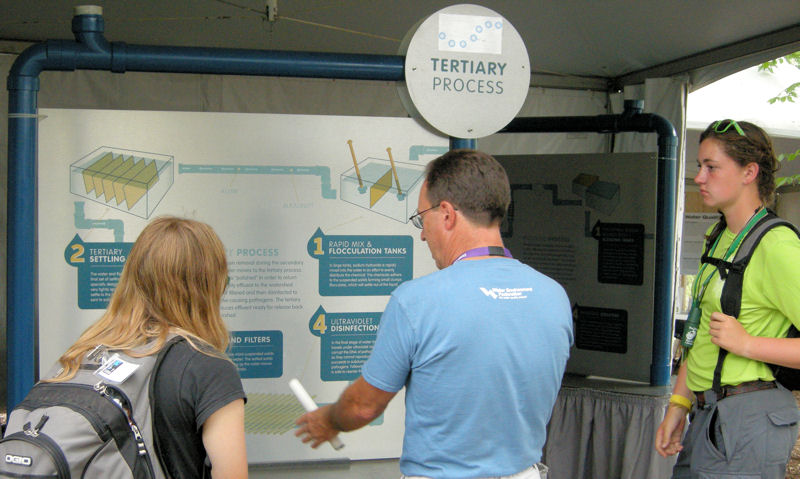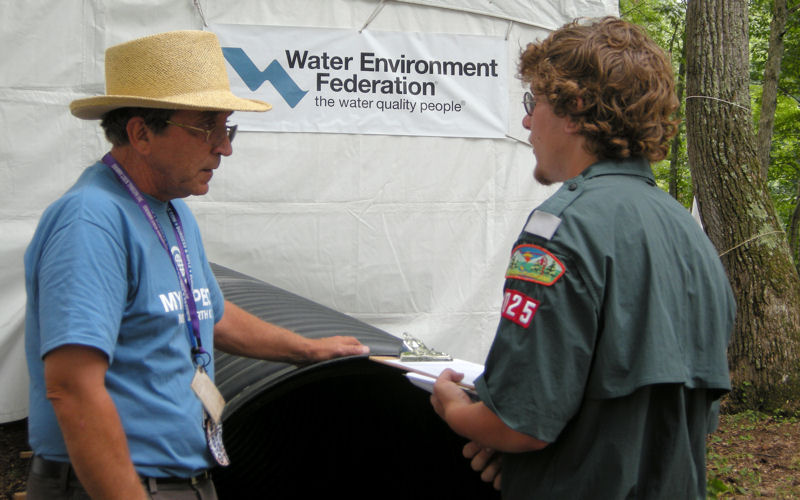
Water Environment Federation (WEF; Alexandria, Va.) volunteer at the 2013 National Scout Jamboree, John Hughes from Infilco-Degremont Technologies (Richmond, Va.), explains the water resource map and shows two Scouts their hometown watersheds. WEF photo/Steve Harrison.
Thirty-eight Water Environment Federation (WEF; Alexandria, Va.) members braved the summer heat to volunteer at the Boy Scouts of America (Washington, D.C.) 2013 National Scout Jamboree. The jamboree was held July 15 to 24 at its new permanent location, Summit Bechtel Reserve in Beckley, W.Va.
In 2010, Carl E. Janson, a past member of the WEF board of trustees, volunteered at the event because of his experience as a Boy Scout and the chance to pass on water knowledge to a new generation.
“I am an Eagle Scout and had attended the jamboree in Valley Forge as a young Scout in 1964 and thought it would be great experience to share my passion for water at the [2013] jamboree,” Janson said.
As president of Riordan Materials Corp. (Crofton, Md.), Janson considered the event important enough to spend 7 days volunteering, 5 of which were personal vacation time.
“I spent time with the Scouts explaining the water resource map, pinning a pin on the map showing where they lived and the watershed where they resided,” Janson said. “I also worked the pipe entrance, explaining the importance of infrastructure and how much of it is out of sight but needs to be updated [or] replaced because of age.”

WEF jamboree volunteer Craig Richards from Burgess & Niple (Columbus, Ohio) educates attendees about wastewater treatment processes. WEF photo/Harrison.
The WEF exhibit was a part of the reserve’s Conservation Trail. Before entering the exhibit, Boy Scouts could pin their homes on a Water Resources Map of the United States to see their watershed. Scouts then entered the exhibit through a 914-mm-diameter (36-in.-diameter) stormwater pipe to see a series of displays on loan from Alexandria (Va.) Renew Enterprises. The displays informed them about primary, secondary, and advanced wastewater treatment and processes used to treat sanitary wastes at the authority’s water reclamation facility. Educational displays emphasized the importance of energy recovery and minimizing our carbon footprint, Janson said.
Scouts also were able to learn about careers in wastewater treatment and look at mircroorganisms that help biologically treat wastewater through a set of microscopes.
Approximately 1000 Scouts visited the WEF exhibit and left with a WEF jamboree pin and a WATER’S WORTH IT™ pin, Janson said.
“The Scouts that visited were enthusiastic about entering the display and learning about water reclamation,” he said. “The pipe entry to the first tent was a big hit,” he added.
“This event is very important,” Janson said. “Many of our country’s business and political leaders have been involved with Scouting. We have the opportunity to share our passion for water with both the Scout leaders and Scouts. They become more aware of the importance of water, our profession, [and] career opportunities and can then help influence our future in water reclamation.”
Scouts also had an opportunity to participate in a day of service. The Beckley (W.Va.) Sanitary Board (BSB) hosted building a rain garden, one of the service activities.
“When they announced that they would institute a day of service component into the jamboree activities, our staff felt it was an excellent opportunity for us to partner on a volunteerism activity to further our mission to improve our local waterways,” said Jeremiah Johnson, BSB general manager.
BSB decided to host construction of the Thomas H. Keyser rain garden so the garden can receive drainage from a local neighborhood, reduce incidents of nuisance flooding, and remove pollutants in urban runoff, Johnson said.
BSB staff excavated the site, installed a storm-sewer-main extension and underdrain construction, and brought the site up to rough grade with constructed biofilter soil before the project. On July 18, 36 Scouts and three Scout leaders joined BSB staff to plant native plants, install sod, lay a flagstone walkway, install two river-rock conveyance channels, set overflow structures, spread mulch, and build a split-rail fence in 5.5 hours.
“All the Scouts worked extremely hard in the hot, humid July weather,” Johnson said. “It was phenomenal.”
“BSB used this as an opportunity to teach the Scouts about urban runoff and its impact upon the water environment,” Johnson said. “We were able to share the role each component of the bioretention cell plays in reducing polluted runoff.”

Volunteer John Peplowski from the Beckley (W.V.a) Sanitary Board talks to a Scout in front of the stormwater pipe entrance to WEF’s educational exhibit at the jamboree. WEF photo/Harrison.
BSB staff members who helped on the project, some of whom are members of WEF, also helped at the jamboree and the jamboree’s WEF exhibit.
“Whether through the onsite exhibit or through the hands-on service project, our jamboree experience reminded each of us of the role this new generation of leaders will play solving many of the challenges facing our nation,” Johnson said. “I had the opportunity to meet Scouts from dozens of states during jamboree, and they left a resounding impression of hope for our future. Hopefully, BSB and WEF [were] able to make each Scout more aware of the importance of water in their lives and perhaps reach a new generation of water-sector professionals.”
Water education is built into the Summit Bechtel Reserve. Boy Scouts of America constructed the reserve as an adventure center for Scout activities, including the jamboree. It emphasizes sustainability with construction of permanent structures, using locally produced materials, and a graywater system. Water used for washing hands is treated onsite and reused to flush toilets, according to the reserve’s website. Water also is conserved with showers that require pulling a chain to run water.
Terradon Corp. (Poca, W.Va.) helped develop the sustainable infrastructure design for the site, which is still in the final phases of construction.
“I look forward to volunteering for the 2017 jamboree and to see the construction of the Bechtel Reserve completed,” Janson said.
— Jennifer Fulcher, WEF Highlights
| For more information about and photos from the 2013 National Scout Jamboree read the WEF WaterBlog entries by volunteers |








August 27, 2013
Featured, WEF Resources & Efforts